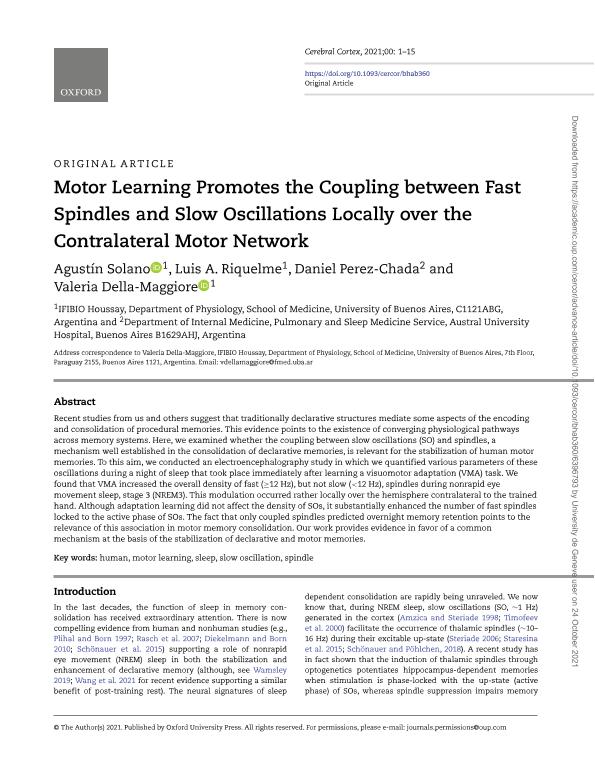Mostrar el registro sencillo del ítem
dc.contributor.author
Solano, Agustín Benjamín Ezequiel

dc.contributor.author
Riquelme, Luis Alberto

dc.contributor.author
Pérez Chada, Daniel

dc.contributor.author
Della Maggiore, Valeria Monica

dc.date.available
2023-09-19T12:56:25Z
dc.date.issued
2021-10
dc.identifier.citation
Solano, Agustín Benjamín Ezequiel; Riquelme, Luis Alberto; Pérez Chada, Daniel; Della Maggiore, Valeria Monica; Motor Learning Promotes the Coupling between Fast Spindles and Slow Oscillations Locally over the Contralateral Motor Network; Oxford Univ Press Inc; Cerebral Cortex; 32; 12; 10-2021; 2493-2507
dc.identifier.issn
1047-3211
dc.identifier.uri
http://hdl.handle.net/11336/211974
dc.description.abstract
Recent studies from us and others suggest that traditionally declarative structures mediate some aspects of the encoding and consolidation of procedural memories. This evidence points to the existence of converging physiological pathways across memory systems. Here, we examined whether the coupling between slow oscillations (SO) and spindles, a mechanism well established in the consolidation of declarative memories, is relevant for the stabilization of human motor memories. To this aim, we conducted an electroencephalography study in which we quantified various parameters of these oscillations during a night of sleep that took place immediately after learning a visuomotor adaptation (VMA) task. We found that VMA increased the overall density of fast (≥12 Hz), but not slow (<12 Hz), spindles during nonrapid eye movement sleep, stage 3 (NREM3). This modulation occurred rather locally over the hemisphere contralateral to the trained hand. Although adaptation learning did not affect the density of SOs, it substantially enhanced the number of fast spindles locked to the active phase of SOs. The fact that only coupled spindles predicted overnight memory retention points to the relevance of this association in motor memory consolidation. Our work provides evidence in favor of a common mechanism at the basis of the stabilization of declarative and motor memories.
dc.format
application/pdf
dc.language.iso
eng
dc.publisher
Oxford Univ Press Inc

dc.rights
info:eu-repo/semantics/openAccess
dc.rights.uri
https://creativecommons.org/licenses/by-nc-sa/2.5/ar/
dc.subject
HUMAN
dc.subject
MOTOR LEARNING
dc.subject
SLEEP
dc.subject
SLOW OSCILLATION
dc.subject
SPINDLE
dc.subject.classification
Neurociencias

dc.subject.classification
Medicina Básica

dc.subject.classification
CIENCIAS MÉDICAS Y DE LA SALUD

dc.title
Motor Learning Promotes the Coupling between Fast Spindles and Slow Oscillations Locally over the Contralateral Motor Network
dc.type
info:eu-repo/semantics/article
dc.type
info:ar-repo/semantics/artículo
dc.type
info:eu-repo/semantics/publishedVersion
dc.date.updated
2023-09-18T13:30:48Z
dc.journal.volume
32
dc.journal.number
12
dc.journal.pagination
2493-2507
dc.journal.pais
Reino Unido

dc.journal.ciudad
Oxford
dc.description.fil
Fil: Solano, Agustín Benjamín Ezequiel. Consejo Nacional de Investigaciones Científicas y Técnicas. Oficina de Coordinación Administrativa Houssay. Instituto de Fisiología y Biofísica Bernardo Houssay. Universidad de Buenos Aires. Facultad de Medicina. Instituto de Fisiología y Biofísica Bernardo Houssay; Argentina
dc.description.fil
Fil: Riquelme, Luis Alberto. Consejo Nacional de Investigaciones Científicas y Técnicas. Oficina de Coordinación Administrativa Houssay. Instituto de Fisiología y Biofísica Bernardo Houssay. Universidad de Buenos Aires. Facultad de Medicina. Instituto de Fisiología y Biofísica Bernardo Houssay; Argentina
dc.description.fil
Fil: Pérez Chada, Daniel. Universidad Austral. Hospital Universitario Austral. Departamento de Medicina Interna. Servicio de Neumonologia.; Argentina
dc.description.fil
Fil: Della Maggiore, Valeria Monica. Consejo Nacional de Investigaciones Científicas y Técnicas. Oficina de Coordinación Administrativa Houssay. Instituto de Fisiología y Biofísica Bernardo Houssay. Universidad de Buenos Aires. Facultad de Medicina. Instituto de Fisiología y Biofísica Bernardo Houssay; Argentina
dc.journal.title
Cerebral Cortex

dc.relation.alternativeid
info:eu-repo/semantics/altIdentifier/url/https://academic.oup.com/cercor/advance-article/doi/10.1093/cercor/bhab360/6396793
dc.relation.alternativeid
info:eu-repo/semantics/altIdentifier/doi/http://dx.doi.org/10.1093/cercor/bhab360
Archivos asociados
